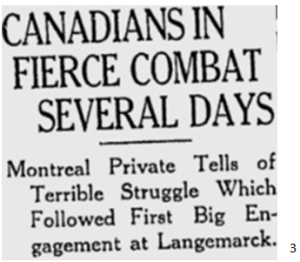Wednesday, April 28, 1915
THIS DAY IN RMR HISTORY: To paraphrase the Ops-Report attached to the War Diary:- “The whole Bn. remained in the Transport lines, H5, during the day of Wednesday April 28th and at dusk that day the Bn. was moved into a position on the west bank of the Yser Canal, I13.” [1]
“…in the Regimental Transport Lines, near Brielen…on the following day [April 28th] Lieuts. W.M. Pearce, G.L. Stairs, E. Leprohon, and F.R. Heuston reported for duty from England. After dusk the Battalion moved into a poorly constructed line of trenches on the west bank of the Yser Canal.” [2]
 “(Canadian Associated Press) London, April 30. – Much has been written of the heroism of the Canadians in recovering their guns, but the fighting on that occasion by no means ends the story of the tremendous conflict around Ypres. It will be remembered that Thursday night was the fatal hour when the charge which has become history was made, but in other parts of the line where the Canadians were engaged the great struggle was followed by fighting no less terrible. It continued throughout Friday, Saturday and Sunday.
“(Canadian Associated Press) London, April 30. – Much has been written of the heroism of the Canadians in recovering their guns, but the fighting on that occasion by no means ends the story of the tremendous conflict around Ypres. It will be remembered that Thursday night was the fatal hour when the charge which has become history was made, but in other parts of the line where the Canadians were engaged the great struggle was followed by fighting no less terrible. It continued throughout Friday, Saturday and Sunday.
The Germans had evolved most extensive plans to capture Ypres and when the true history of the fighting of the past ten days is written it will be seen that the Canadians alongside the British fought with great heroism, at times against tremendous odds.
MONTREAL MAN’S STORY: Stories of the wounded arriving today show the dastardly way which the Germans use the asphyxiating gases. One Canadian tells how they shelled the hospital in which he was temporarily placed. A private of the Royal Montreal Reg’t. gave a vivid story today of the fighting during the three days following the recapture of the guns: ‘We had a marvellous escape,’ he remarked. ‘I did not think the wound in my leg, practically in three places, was so bad, but eventually I had to give way. A bugler, a young, courageous fellow of an English regiment, picked me up in the open. Bullets from machine guns were flying around, as well as shrapnel. He was practically carrying me when shrapnel burst over our heads. He was struck in the chest and killed instantly. I fell and crawled to a place behind a turnip patch where I lay until picked up by a stretcher-bearer. We had not gone far, he carrying me, until he also was shot. Shortly after I was taken to a dressing station.’
The private preceded these details of himself by reference to the heavy fighting in which the Canadians were engaged, meeting a strong force of Germans, many of whom, by the way, appeared in khaki and kilts. His battalion had been in the trenches five days prior to Thursday, and had gone back for a rest. ‘On that night,’ he said, ‘we saw clouds of asphyxiating gases coming towards us from north of Ypres. Then came an ammunition wagon and afterwards a number of refugees doing their best to get away from the fire. We took up our position about ten Thursday night. On Friday morning the Germans retired a little and we advanced, but in consequence of shell fire we went back a short distance. So we remained till Friday night, when we moved and took up a new position. Several English regiments with us, we were stationed on what may be described as a large open plain with no trenches. We understood the Germans were about four or five hundred yards in front. We dug ourselves small trenches two feet wide and four deep, something in the form of a square. About four Saturday morning a tremendous shell fire opened from the Germans who were on the left. ‘Coal boxes’ rained upon us and the position consequently became so hot that it was impossible for us to hold it, so we decided to make a retiring movement. At that moment a large body of Germans were noticed coming up almost behind us on the right.
The situation was critical. From two sides the shell fire became terrible. We had the order to retire by companies, but the only possible retirement was across an open plain consisting of three fields of turnips and hay stubble. A slight ridge occupied by the Germans gave them command of this plateau. Here they placed a number of machine guns, and the fire as we retired was awful. I saw many men round me fall. It was then I was hit. In these days following the capture of the guns we had terrible fighting, I came through Ypres which appeared razed to the ground.’
Concluding his story the private spoke of the heroic work of the stretcher-bearers in rescuing wounded under fire.” [4]
[1] Operation-Report of May 6th, 1915, War Diary, 14th Canadian Battalion, The Royal Montreal Regiment. Library and Archives Canada, Ottawa. http://data2.collectionscanada.ca/e/e044/e001089726.jpg
[2] R.C. Featherstonhaugh, The Royal Montreal Regiment 14th Battalion C.E.F. 1914-1925, Montreal, The Gazette Printing Co., Ltd., 1927, pg. 45.
[3] “Canadians in Fierce Combat Several Days,” The Citizen, Ottawa, Ontario, Friday, April 30, 1915, pg. 6, col. 1.
[4] Ibid

